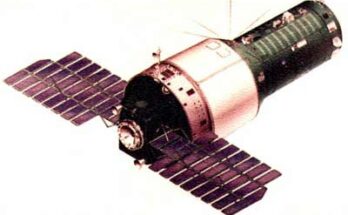by Bill Ostrove, Space Systems Analyst, Forecast International.
The U.S. Air Force’s fifth and sixth Space-Based Infrared System (SBIRS) reconnaissance satellites will be based on updated versions of Lockheed Martin’s A2100 platform. The contract modification was signed on June 9 following negotiations between the USAF Space and Missile Systems Center and Lockheed Martin Space Systems. The effort will modernize the geosynchronous Earth orbit (GEO) spacecraft for the fifth and sixth satellites at no additional cost to the $1 billion bulk-purchase contract originally awarded in June 2014.
Lockheed Martin submitted a proposal on December 8, 2014, in response to the U.S. Department of Defense’s need for improvements to its SBIRS fleet. The bid included the recommendation to update the current A2100 satellite with a modernized version that is functionally equivalent to the current SBIRS baseline. Benefits of the modernization include increased commonality with other space systems, added satellite resiliency, reduced parts obsolescence, potential for a significant cost savings on future satellite buys, and increased interface flexibility on the satellite to ease future modernization of the onboard sensor suite.
According to Col. Mike Guetlein, program director of the USAF Remote Sensing System Directorate, “The modernized satellite provides a pathway for implementing the next-generation of capabilities being pursued under the Air Force’s Space Modernization Initiative. In the end, the next-generation capabilities will enable warfighters to see dimmer targets faster, which will allow commanders to keep our troops on the battlefield, as well as our nation and our allies, safe.”
Implementing the SBIRS production effort under a fixed-price-incentive (firm-target) arrangement caps the contract cost to the Air Force while simultaneously allowing the Air Force to realize the technical benefits of modernization. “The incentive contract arrangement opened up opportunities for the Air Force to restructure the business deal to appropriately share cost risk with Lockheed Martin,” Guetlein said. “It also allowed us to rebalance the incentives between cost, schedule, and system performance to ensure alignment with our program goals to field an amazing capability for our warfighters.”
The Air Force is taking advantage of a streamlined approach that merges military requirements with Lockheed Martin’s internal processes to improve commonality across military and commercial programs. Additionally, the USAF is benefiting from investments in the A2100 that Lockheed Martin has already made.
The SBIRS GEO-1 spacecraft was launched in May 2011, representing the culmination of years of work and billions of dollars spent developing the SBIRS system. The second SBIRS satellite followed in March 2013. Three highly elliptical orbit payloads have launched as well. With these launches, the U.S. Air Force hopes to have moved beyond the delays and technical issues that have sidetracked the program throughout its development. The Air Force is now focused on production and incremental improvements.
For 50 years, Forecast International intelligence reports have been the aerospace and defense industry standard for accurate research, analysis, and projections. Our experienced analysts compile, evaluate, and present accurate data for decision makers. FI's market research reports offer concise analysis of individual programs and identify market opportunities. Each report includes a program overview, detailed statistics, recent developments and a competitive analysis, culminating in production forecasts spanning 10 or 15 years. Let our market intelligence reports be a key part of reducing uncertainties and mastering your specific market and its growth potential. Find out more at www.forecastinternational.com



